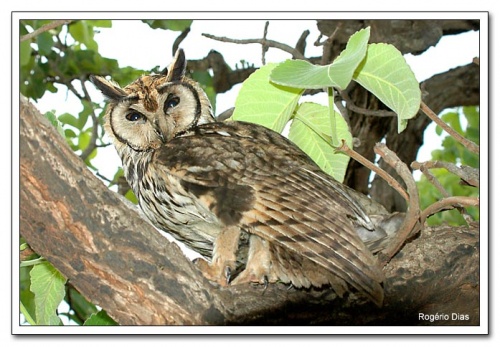(GS amended to allow for both scientific names) |
|||
| Line 19: | Line 19: | ||
Nocturnal. | Nocturnal. | ||
| − | The diet includes spiny rats, rice rats, cavies, bats and opossums, doves, grassquits, flycatchers, thrushes, house sparrows and tinamous. | + | The diet includes spiny rats, rice rats, cavies, bats and opossums, doves, grassquits, flycatchers, thrushes, house sparrows and tinamous. Rarely taken foods include large insects and a few reptiles. The relative importance of mammals vs birds vary geographically, but larger prey (>100 g) seems to be a general feature. |
2-4 eggs are laid in nests on the ground in long grass and dense bushes. The female alone incubates for approximately 33 days. | 2-4 eggs are laid in nests on the ground in long grass and dense bushes. The female alone incubates for approximately 33 days. | ||
| Line 27: | Line 27: | ||
Begging call. Recording by {{user|Andrew+Whitehouse|Andrew Whitehouse}} | Begging call. Recording by {{user|Andrew+Whitehouse|Andrew Whitehouse}} | ||
| + | |||
==References== | ==References== | ||
# Clements, James F. 2007. ''The Clements Checklist of Birds of the World''. 6th ed., with updates to October 2007. Ithaca: Cornell University Press. ISBN 9780801445019 | # Clements, James F. 2007. ''The Clements Checklist of Birds of the World''. 6th ed., with updates to October 2007. Ithaca: Cornell University Press. ISBN 9780801445019 | ||
Revision as of 02:31, 5 July 2017
- Pseudoscops clamator
Asio clamator
Identification
30-38cm. Ear tufts are well developed and projected to the sides or to the top of the head. White black-rimmed facial disc, dark brown eyes and black bill. Its upperparts are yellowish-brown to tawny–ochre, striped with grimy brown. Below it is buff or white, with dark brown stripes. Short wings and a long tail, the flight feathers and tail have alternated buff and grimy brown bands. Tarsi and toes are feathered.
Distribution
Southern Mexico to Panama, and from northern South America (including Tobago but not Trinidad) to Uruguay and north Argentina, east of the Andes.
Taxonomy
This species has in the past been placed in genera Rhinoptynx and Asio; a footnote in the SACC baseline indicates that the placement in Asio is correct, but not enough of the checklists have followed this for Opus to make the change.
Subspecies:
- P. c. clamator
- P. c. forbesi
- P. c. midas
- P. c. oberi only found in Tobago
Habitat
Open or semi-open grassland and savannas with scattered trees, small groves and bushes, open marshland with bushes, pasture and agricultural land, as well as in wooded suburban areas. The subspecies oberi in Tobago seems more strictly limited to forest and forest edges, and possibly threatened by forest fragmentation in at least part of its range. Other populations may actually benefit from deforestation.
Behaviour
Nocturnal.
The diet includes spiny rats, rice rats, cavies, bats and opossums, doves, grassquits, flycatchers, thrushes, house sparrows and tinamous. Rarely taken foods include large insects and a few reptiles. The relative importance of mammals vs birds vary geographically, but larger prey (>100 g) seems to be a general feature.
2-4 eggs are laid in nests on the ground in long grass and dense bushes. The female alone incubates for approximately 33 days.
Vocalisation
<flashmp3> Striped Owl Begging Regua 18h10m39s17sep2008.mp3</flashmp3>
Listen in an external program
Begging call. Recording by Andrew Whitehouse
References
- Clements, James F. 2007. The Clements Checklist of Birds of the World. 6th ed., with updates to October 2007. Ithaca: Cornell University Press. ISBN 9780801445019
- König, C. and F. Weick 2008. Owls of the World, second edition. Christopher Helm, London. ISBN 978-0-7136-6548-2
- Information seen at conference of the Society for Conservation and Study of Caribbean Birds




